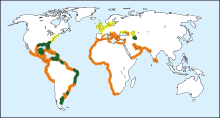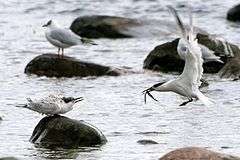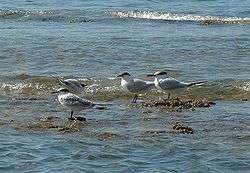Sandwich tern
| Sandwich tern | |
|---|---|
 | |
| Scientific classification | |
| Kingdom: | Animalia |
| Phylum: | Chordata |
| Class: | Avese |
| Order: | Charadriiformes |
| Family: | Laridae |
| Genus: | Thalasseus |
| Species: | T. sandvicensis |
| Binomial name | |
| Thalasseus sandvicensis (Latham, 1787) | |
 | |
| Range of T. sandvicensis Breeding range Year-round range Wintering range | |
| Synonyms | |
|
Sterna sandvicensis | |
The Sandwich tern (Thalasseus sandvicensis)[2] is a tern in the family Laridae. It is very closely related to the lesser crested tern (T. bengalensis), Chinese crested tern (T. bernsteini), Cabot's tern (T. acuflavidus), and elegant tern (T. elegans) and has been known to interbreed with the lesser crested.
The Sandwich tern is a medium-large tern with grey upperparts, white underparts, a yellow-tipped black bill and a shaggy black crest which becomes less extensive in winter with a white crown. Young birds bear grey and brown scalloped plumage on their backs and wings. It is a vocal bird. It nests in a ground scrape and lays one to three eggs.
Like all Thalasseus terns, the Sandwich tern feeds by plunge diving for fish, usually in marine environments, and the offering of fish by the male to the female is part of the courtship display.
Taxonomy
_(6).jpg)
The terns are small to medium-sized seabirds, gull-like in appearance, but usually with a more delicate, lighter build and shorter, weaker legs. They have long, pointed wings, which gives them a fast buoyant flight, and often a deeply forked tail. Most species are grey above and white below, and have a black cap which is reduced or flecked with white in the winter.[3]
The Sandwich tern was originally described by ornithologist John Latham in 1787 as Sterna sandvicensis, but was recently moved to its current genus Thalasseus (Boie, 1822) following mitochondrial DNA studies which confirmed that the three types of head pattern (white crown, black cap, and black cap with a white blaze on the forehead) found amongst the terns corresponded to distinct clades.[2] The current genus name is derived from Greek Thalassa, "sea", and sandvicensis, like the English name, refers to Sandwich, Kent, Latham's type locality. In birds, the specific name sandvicensis usually denotes that the species was first described from Hawaii, formerly known as the "Sandwich Islands", but the Sandwich tern does not occur there.[4]
This bird has no subspecies. Two former subspecies are now treated as a separate species called Cabot's tern (T. acuflavidus), which breeds on the Atlantic coasts of North America, wintering in the Caribbean and further south, and has wandered to Western Europe. The former species, T. s. eurygnatha (Saunders 1876), is sometimes treated as a separate species called the Cayenne tern (T. eurygnatha), which breeds on the Atlantic coast of South America from Argentina north to the Caribbean, intergrading with T. acuflavidus in the north of its range. The DNA analysis showed that Cayenne tern differed genetically from T. acuflavidus, but the difference was not sufficient to confirm it as a definite separate species.[2]
Description
This is a medium-large tern, 37–43 cm (15–17 in) long with an 85–97 cm (33–38 in) wingspan, which is unlikely to be confused within most of its range, although the South American race could be confused with the elegant tern.
The Sandwich tern's thin sharp bill is black with a yellow tip, except in the yellow or orange billed South American race. Its short legs are black. Its upperwings are pale grey and its underparts white, and this tern looks very pale in flight, although the primary flight feathers darken during the summer.[5]

The lesser crested tern and elegant tern differ in having all-orange bills; lesser crested also differs in having a grey rump and marginally stouter bill, and elegant in having a slightly longer, slenderer bill. Chinese crested tern is the most similar to Sandwich, but has a reversal of the bill colour, yellow with a black tip; it does not overlap in range with Sandwich tern so confusion is unlikely.
In winter, the adult Sandwich tern's forehead becomes white. Juvenile Sandwich terns have dark tips to their tails, and a scaly appearance on their back and wings, like juvenile roseate terns.[5]
The Sandwich tern is a vocal bird; its call is a characteristic loud grating kear-ik or kerr ink.[5]
Behaviour
This species breeds in very dense colonies on coasts and islands, and exceptionally inland on suitable large freshwater lakes close to the coast. It nests in a ground scrape and lays one to three eggs. Unlike some of the smaller white terns, it is not very aggressive toward potential predators, relying on the sheer density of the nests—often only 20–30 cm (7.9–11.8 in) apart and nesting close to other more aggressive species such as Arctic terns and black-headed gulls to avoid predation.
Like all Thalasseus terns, the Sandwich tern feeds by plunge-diving for fish, almost invariably from the sea. It usually dives directly, and not from the "stepped-hover" favoured by Arctic terns. The offering of fish by the male to the female is part of the courtship display.
Status
The Sandwich tern has an extensive global range estimated at 100,000–1,000,000 km2 (39,000–386,000 sq mi). It has a population estimated at 460,000–500,000 individuals. Population trends have not been quantified, but the species is not believed to approach the thresholds for the population decline criterion of the IUCN Red List (i.e., declining more than 30% in ten years or three generations). For these reasons, the species is evaluated as least concern.[1]
The Sandwich tern is among the taxa to which the Agreement on the Conservation of African-Eurasian Migratory Waterbirds (AEWA) applies.[6] Parties to the agreement are required to engage in a wide range of conservation actions which are describes in a detailed action plan. This plan should address key issues such as species and habitat conservation, management of human activities, research, education, and implementation.[7]
 T. sandvicensis approaching its waiting offspring with a fish
T. sandvicensis approaching its waiting offspring with a fish T. sandvicensis with common terns
T. sandvicensis with common terns ID composite
ID composite
References
- 1 2 BirdLife International (2015). "Thalasseus sandvicensis". IUCN Red List of Threatened Species. IUCN. 2015: e.T22694591A85104473. Retrieved 28 May 2016.
- 1 2 3 Bridge, Eli S.; Jones, Andrew W.; Baker, Allan J. (2005). "A phylogenetic framework for the terns (Sternini) inferred from mtDNA sequences: implications for taxonomy and plumage evolution". Molecular Phylogenetics and Evolution. 35 (2): 459–469. PMID 15804415. doi:10.1016/j.ympev.2004.12.010.
- ↑ Snow, David; Perrins, Christopher M., eds. (1998). The Birds of the Western Palearctic (BWP) concise edition (2 volumes). Oxford: Oxford University Press. p. 764. ISBN 0-19-854099-X.
- ↑ Jobling, James A (2010). The Helm Dictionary of Scientific Bird Names. London: Christopher Helm. pp. 347, 383. ISBN 978-1-4081-2501-4.
- 1 2 3 Hume, R. (2002). RSPB Birds of Britain and Europe. London: Dorling Kindersley. p. 186. ISBN 0-7513-1234-7.
- ↑ "Annex 2: Waterbird species to which the Agreement applies". Agreement on the conservation of African-Eurasian migratory Waterbirds (AEWA). UNEP/ AEWA Secretariat. Retrieved 28 May 2016.
- ↑ "Introduction". African-Eurasian Waterbird Agreement. UNEP/ AEWA Secretariat. Retrieved 28 May 2016.
Further reading
- Olsen, Klaus Malling; Larsson, Hans (1995). Terns of Europe and North America. London: Christopher Helm. ISBN 0-7136-4056-1.
- Stienen, Eric W.M. (2006). Living with gulls: trading of food and predation in the Sandwich Tern Sterna sandvicencis (PhD Thesis). University Groningen.
External links
| Wikimedia Commons has media related to Thalasseus sandvicensis. |
| Wikispecies has information related to: Thalasseus sandvicensis |
- BirdLife species factsheet for Thalasseus sandvicensis
- "Thalasseus sandvicensis". Avibase.
- "Sandwich tern media". Internet Bird Collection.
- Sandwich tern photo gallery at VIREO (Drexel University)
- Sandwich tern species account at NeotropicalBirds (Cornell University)
- Interactive range map of Thalasseus sandvicensis at IUCN Red List maps
- Audio recordings of Sandwich tern on Xeno-canto.
- Thalasseus sandvicensis in the Flickr: Field Guide Birds of the World
- Sandwich tern media at ARKive

